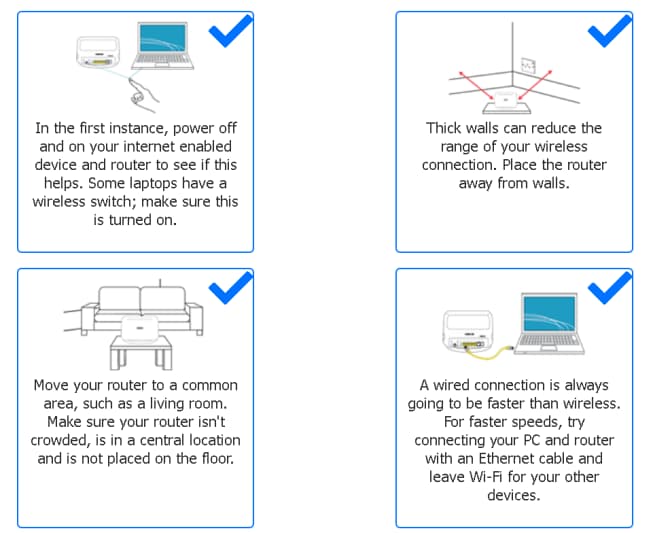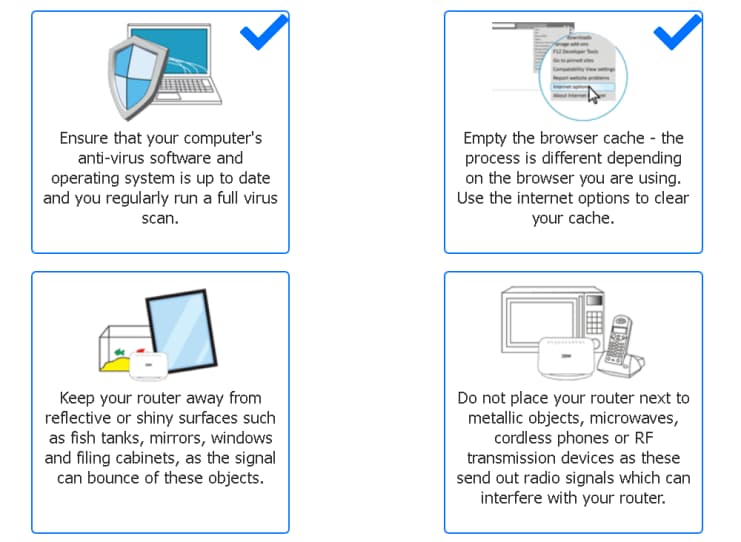FAQs
Got a Question?
At Twyce Digital we value and encourage customer feedback on any aspect of our service.
How do I change the wireless channel and network name?
Your wireless performance could be slowing down due to interference from other wireless networks in your area.
From time to time, other devices in your area could overlap onto the channel your router is broadcasting on and will compete for airwaves, causing interference or “noise” which will in turn cause the Wi-Fi to slow down. You can try and overcome this by changing the channel/frequency that your router will communicate on.
Your router will automatically look for the channel with the least interference or “noise”. This is more prevalent for 5G on channels above 48, this issue wouldn’t affect routers with band steering enabled. This issue doesn’t apply to 2.4G on the newer routers.
To do this:
- Power your router on and off. Your router will then automatically scan for the channel with the least noise.
- Log in to the router and select “Network settings” and then “wireless”
- Changing of channels on the dual band cannot be done through the admin access.
How do I change the encryption type and key?
There are a number of options you can select:
No security
This is not recommended by seethelight as this will allow anyone with a wireless device to connect to your router and use your internet connection and possibly access devices and information in your home network. This option would generally be used for fault finding and turning it to this mode is at your own risk.
WEP
This is an older version of security and although it is secure, it is the weakest of the options. This works best with older router models.
WPA
This option is more secure than WEP and the password can be letters and numbers.
WPA2
This is the latest security standard and is the recommended security type. The password can be letters and numbers. We recommend your regularly change the encryption type and key to help you keep your wireless network secure.
- Log into the router and select “Network settings” and then choose “wireless” and then scroll to the bottom of this screen.
- Here you will be able to change the encryption type and key (password).
Setting up a wireless network
- Insert an Ethernet cable into the Lan 1 port of the ONT
- Take the other end of the cable and insert it into the WAN port of your router. Where possible, try to place your router in an open space.
- You will now be able to find the wireless network and connect using your SSID and encryption key.
How and when will my router be delivered?
When you sign up for our internet broadband service, we will send you a free wireless router, We use a courier service which offers many benefits. You will receive updates from the courier service on the date and time of your router will be delivered.
You can track the delivery of the router in real time by logging into their website. If you are not going to be in, you can ask for it to be delivered to an alternative address or to a safe place.
Configuring your router or changing its settings
If you would like to change any of your router’s settings, such as changing the admin password, changing the router’s channel or changing the encryption type and key, then you can do so by launching your web browser and using the log in details at the back of your router. If your router comes with a configuration application, you can change your router details through the application.
Your equipment explained
Because we use fibre to bring you high-speed internet, we use some equipment that you may not be familiar with. The major part of your equipment is the ONT
ONT (Optical Network Terminal)
This is where the light that passes through the fibre optics on the network and later converted into electrical signals for use by your telephone or computer. The ONT is typically located at a place in your house (though this may vary from house to house). It has LAN and Telephony ports situated on the underside.
How do I improve slow speeds?
Many things can cause interference to wireless networks, so there are things you can do to prevent these interferences and hence, improve your wireless connection. Like radio and television waves, wireless is subject to interference from electrical sources. If you have low signal strength, or you keep losing connection, it could be because some objects are interfering with your router and causing ‘noise’. Your wireless signal will be the strongest when it is clear of any obstacles and is in a clear space. Try these tips to get the best out of your wireless:


I don't seem to be achieving my advertised connection speed - what can I do?
Not all speed testers available via the internet are able to cope with the speeds possible on a fibre connection. We have provided a more accurate test here for you to use: www.speedtest.net
There are also a number of factors beyond our control that can affect your speed. For example, wireless networks are slower than wired, old hardware or incompatible software could be causing performance problems, viruses or malware could be slowing your PC down, the internet is a shared resource and speed is dependent on the number of users online, you may have a number of programs running on the computer or you may have a number of computers, games consoles or devices sharing the connection.
For information on how you may be able to improve your connection speed please see the ofcom Broadband Guide
Why you may be experiencing slow speeds
- Wireless networks are slower than a wired connection
- Computer performance problems caused by old hardware or incompatible software Viruses or malware slowing your PC down.
- The general internet is busy – the internet is a shared resource and speed is dependent on the number of users online.
- The number of programs running on the computer such as peer-to-peer (P2P) software.
- The total amount of computers, games consoles or internet enabled devices sharing the internet connection.
- Your wireless performance could be slowing down due to interference from other wireless networks in your area. Your router will automatically look for the channel with the least interference or “noise”, however from time to time, other devices in your area could overlap onto the channel your router is broadcasting on and will compete for the airwaves, causing the Wi-Fi to slow down. You can try and overcome this by changing the channel/frequency that your router will communicate on.
- Try disabling your firewall software and then try to connect again. If this works then contact your firewall supplier for more help
- Remove any old wireless networks as your router may be trying to connect to these instead of the new one.
- Change the Wireless Network Name (SSID) of the router and then try connecting to this newly named network. If you are using a router not supplied by Twyce Digital then refer to the manufacturer’s instructions.
- Check the lights on your router to make sure there are no faults here.
What is band steering?
Band steering is a technique used by some dual-band routers to allow most modern smartphones, tablets, laptops, and PCs, to use the higher capacity 5ghz frequency when close to the router and the more versatile 2.4ghz frequency when distance is an issue.
This is usually advantageous because 5GHz tends to be better for WiFi performance as it has more and wider channels available with less overall interference from both neighbouring WiFi and non-WiFi sources. Band Steering helps improve user experience by reducing utilisation, especially in high density environments.
How do I remove wireless networks?
Windows XP
- Open network connections and right click Wireless Network Connections, then click properties.
- Under preferred networks, click the wireless network you want to remove and select “Remove”.
Windows Vista
- Click “Start”, right click “Network” and then select “Properties”
- Open network connections and right click Wireless Network Connections, then click properties.
- Under preferred networks, click the wireless network you want to remove and select “Remove”.
Windows 7, 8 and 10
- Open your Control Panel and select “Network and Sharing Centre” and then click on “Manage Wireless Networks”.
- Select the old connection you wish to remove from the list and select “Remove”
When accessing certain websites, I am receiving notification I am in a foreign country. What can I do?
Have you experienced problems accessing certain websites?
If you are having issues accessing certain websites, seen an error message such as “This programme is unavailable in your territory” or have received notification that you are in a different country which prohibits you accessing websites similar to the ones listed, it could be because your IP address is showing your location as being in a foreign country. Whilst this is not the case, this is a well-known common issue that we can help you solve caused by a world-wide shortage of IP addresses. To solve, switch your ONT off then on repeatedly for about 3 times. A new IP address will be allocated to you by the network.
Are you having slow speeds and drop outs?
One of the most common problems reported to us is apparent slow speeds or service drop outs. The problem is usually caused by the Wi-Fi used to link devices to the router and is especially common in new homes which often have foil backed insulation inside internal walls.
We offer a comprehensive telephone diagnostic service if you are experiencing speed or WiFi issues. If you are experiencing issues, please call our Tech Support team or get in touch on webchat or send us an email via our contact us page.
Using speed tests using VPN / powerline adaptors
When doing speed tests, you should always ensure you are doing tests on wired connections, as wireless connections can be susceptible to interferences.
Doing speed tests over VPN or whilst using a powerline adaptor will not work.
I can't get a connection
- Check that all cables are attached correctly and that your computer and router are switched on.
- If you’re using a wireless connection, try a wired connection instead to isolate where the problem lies.
- Ensure that the WAN port of the router is connected to LAN 1 or 2 of the ONT.
- Some laptops have a switch to turn the wireless connection off or on.
- Make sure this switch is set to ‘on’ Turn off both your computer and router. After a minute or so, turn them on and try again.
- Ensure that your computer’s antivirus software is up to date and you regularly run a full virus scan.
- Disable background programs such as file-sharing or peer-to-peer (P2P). These programs consume the computer’s system resources and use your broadband bandwidth to upload and download files.
- Empty the browser cache – the process is different depending on the browser you are using. For Internet Explorer 11 go to Tools, Internet Options then click Delete. In the next window select Temporary Internet Files and click Delete.
Setting up your router using your internal wiring
- Insert an Ethernet cable into the Lan 1 port of the ONT.
- Insert the other end directly into the relevant port of the patch panel, associated with the room where you would like services*.
- In the relevant room, find your data port and insert an Ethernet cable into the WAN port of your router. You will now be able to connect to the internet.
* If your patch panel is not labelled with rooms, try each port until there is a match.
What if I haven't got internal wiring
If you haven’t got internal wiring, you could try moving your router to a more central location using Ethernet cables. Avoid trip hazards by ensuring cables are not dragged across open floor spaces, door openings, stairs or walkways.
My internal wiring isn't working
We are not responsible for internal wiring or troubleshooting internal wiring issues. The internal wiring is the responsibility of the customer or customer’s landlord. To resolve an internal wiring issue, please contact a qualified electrician.
Whose responsible for internal wiring in my property?
The responsibility for internal wiring lies with the customer or the customer’s landlord.
Can I bring my old telephone number with me?
Our customers are often able to keep their telephone number subject to a transfer charge. Once the application is made the charge will be payable. For you to transfer your existing number, the number must be active with your provider until the transfer process is completed.
Can I choose my telephone number?
We do not offer a choice of telephone number at this time.
How do I check the cost of a call before I ring the number?
To check how much individual numbers costs, you can view our tariff document here.
How do I activate or deactivate Voicemail on my telephone?
Just dial 1571 to access the voicemail menu; you will then hear a series of instructions that tell you how to listen to your messages, change your voicemail greeting, or change your voicemail password.
If there’s a message waiting for you, you will hear an interrupted dial tone when you pick up the telephone. Your voicemail will store up to 30 messages and old messages are automatically deleted after 20 days. You will receive a warning when your voicemail is full via a recorded message when you dial 1571.
How is my first bill calculated?
Your first bill is 5 days after your activation. After that, bills are produced on or around the 1st or 15th of the month (or the next working day after the 1st or 15th if it falls on the weekend or bank holiday). Services are charged one month in advance. Your first bill will also include service costs accrued from the date of activation up to the date the bill was produced.
How is my first bill calculated?
Payments are to be made by Direct Debit. Payments not made by Direct Debit will incur a charge of £5.00 per month. You can make payments using a debit or credit card.
Are my card payment details safe?
We are in compliance with the payment card industry data security standard (PCI). PCI is a set of requirements with which all businesses who take credit or debit card payments must comply.
What should I do if I am moving house?
If you are moving house, we require 30 days notice in writing from the account holder. Please send an email to: billing@twycedigital.com. We will need your account number, installation address, your name and your new address. There may be circumstances where we require proof of your forwarding address; we will advise if this is applicable to you.
How do I upgrade or downgrade my services?
Contact us so we can assist you with your upgrade/downgrade. To make the transition as easy as possible and to track on your bill all upgrades/downgrades will be actioned to go live on your next invoice date. Upgrades/Downgrades are subject to a one-off charge.
I have not received my e-bill notification. Why is this?
If you have not received your e-bill notification, you could try checking your junk folder, in case it has been directed there. To stop you missing future correspondence add us to your contact list. If you still have issues, please contact us
What can I do if I am struggling to pay for my bills?
We understand it can sometimes be hard to find the money to pay for household bills. For information on how we can help you if you are struggling with your bills, please contact us.
